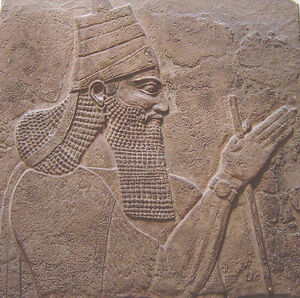Τιγλοπλάσωρ Γ'
Tiglath-Pileser III, Tukultī-apil-Esharra


Ασσυρία Ηγεμόνες Ασσυρίας
>>Αρχαιο-Ασσυριακή<< Δυναστεία 1η Δυναστεία 2η
>>Παλαιο-Ασσυριακή<< Δυναστεία 3η Δυναστεία 4η Δυναστεία 5η
>>Μεσο-Ασσυριακή<< Δυναστεία 6η Δυναστεία 7η Δυναστεία 8η
>>Υστερο-Ασσυριακή<< Δυναστεία 9η Δυναστεία 10η
Βαβυλωνία Ηγεμόνες Βαβυλωνίας
Λάρισα (Larsa) Ηγεμόνες Λάρισας
Ισίνεια (Isin) Ηγεμόνες Ισίνειας
Εσνύννεια (Esnunna) Ηγεμόνες Εσνύννειας
Μάρεια (Mari) Ηγεμόνες Μάρειας
Σουμερία (Sumer) Ηγεμόνες Σουμερίας
Ακκαδία (Akkad) Ηγεμόνες Ακκαδίας
Ελυμαΐδα (Elam) Ηγεμόνες Ελυμαΐδας
Συρία Ηγεμόνες Συρίας
Μιταννία (Mitanni) Ηγεμόνες Μιταννίας
Ουραρτία (Urartu) Ηγεμόνες Ουραρτίας
Χετταϊκή Αυτοκρατορία (Hatti) Ηγεμόνες Χετταϊκής Αυτοκρατορίας
Αιγυπτιακή Αυτοκρατορία (Egypt) Ηγεμόνες Αιγυπτιακής Αυτοκρατορίας
Μυκηναϊκή Ελλάδα Ηγεμόνες Μυκηναϊκής Ελλάδας
Αμορραίοι Αραμαίοι Χαναναίοι
- Χρονική Περίοδος Διακυβέρνησης: Νεο-Ασσυριακή Εποχή,
- Γέννηση:
- Θάνατος:
Ετυμολογία[]
| της Ασσυρίας
|
|---|
| Νεότερη Περίοδος |
Adad-nirari II
|
Tukulti-Ninurta II
|
Ashur-nasir-pal II
|
Shalmaneser III
|
Shamshi-Adad V
|
Adad-nirari III
|
Sammu-ramat
|
Shalmaneser IV
|
Ashur-Dan III
|
Ashur-nirari V
|
Tiglath-Pileser III
|
Shalmaneser V
|
Sargon II
|
Sennacherib
|
Esarhaddon
|
Ashurbanipal
|
Ashur-etil-ilani
|
Sin-shumu-lishir
|
Sin-shar-ishkun
|
Πτώση Νινευίδας,
|
Ashur-uballit II
|
Πτώση Χαρράνειας
|
Το όνομα "Tukultī-apil-Esharra" είναι εξελληνισμός του Ασσυριακού ονόματος "Άσσωρ".
Γενεαλογία[]
- Οίκος:
- Πατέρας:
- Μητέρα:
- Σύζυγος:
- Τέκνα:
Βιογραφία[]
- Τα σημαντικότερα ιστορικά γεγονότα, κατά την διάρκεια του βίου του, είναι:
Assyrian power in the Near East greatly increased as the result of Tiglath-Pileser's military reforms (see "Reforms" below) and of his campaigns of conquest.
Upon ascending the throne, he claimed (in Annal 9, which dates to 745 BCE, his first regnal year) to have annexed Babylonia, from "Dur-(Kuri)galzu, Sippar of Shamash, ... the cities [of Babylonia up to the Uqnu river by the shore of the Lower Sea" (which referred to the Persian Gulf), and subsequently placed his eunuch over them as governor.
Also in his first year of reign he defeated the powerful kingdom of Urartu (Armenia), whose hegemony under the rulership of Sarduri II had extended to Asia Minor, northern Mesopotamia, western Iran and Syria; there he found unrivalled horses for his war-chariots.
He also defeated the Medes before making war on and conquering the Neo-Hittites, Syria and Phoenicia.
He took Arpad in 740 BCE, after three years of siege, annexed it as a province (over which he placed one of his eunuchs as governors), and subjected Hamath to tribute.
Assyrian inscriptions record in 740 BCE, the fifth year of his reign, a victory over Azariah (Uzziah), king of Judah, whose achievements appear in 2 Chronicles 26.
He also subjugated Damascus, the Arabs under Queen Zabibe, Menahem of Israel and Sam'al's king Azriyau, who all paid him tribute.
In 737 and 736 BCE he turned his attention again to Iran, conquering the Medes and Persians and occupying a large part of Iran.
According to the royal inscriptions of Tiglath-Pileser many of the inhabitants were enslaved and deported to other parts of the Assyrian empire, as commonly done by his predecessors. At sieges, captives were slaughtered, and their bodies raised on stakes and displayed before the city.
In October 729 BCE, Tiglath-Pileser assumed total control of Babylon, capturing the Babylonian king Nabu-mukin-zeri (ABC 1 Col.1:21) and having himself crowned as "King Pulu of Babylon."
Tiglath-Pileser III's conquests and reforms led to the establishment of the Neo-Assyrian Kingdom as a true empire.
He built a royal palace in Kalhu (the biblical Calah/Nimrud, the so-called "central palace"), later dismantled by Esarhaddon. He had his royal annals engraved across the bas-reliefs depicting his military achievements on the sculptured slabs decorating his palace.
On his death, he was succeeded by his son Ululayu, who took the name Shalmaneser V and further campaigned in the Levant, defeated Egypt, and captured Samaria.
Biblical account[]
Biblical records describe how Tiglath-Pileser III exacted 1,000 talents of silver as tribute from King Menahem of the kingdom of Israel (Samaria) (2 Kings 15:19) and later defeated his successor Pekah (2 Kings 15:29).
Pekah had allied with Rezin, king of the Arameans against Ahaz (known to the Assyrians as Yahu-khazi), of the Kingdom of Judah, who responded by appealing for the Assyrian monarch's help with the Solomon's Temple gold and silver.
Tiglath-Pileser answered swiftly. He first marched his army down the eastern Mediterranean coast, taking coastal cities all the way to Egypt. This cut off his enemies' access to the sea.
Once this was achieved, he returned to the Northern Kingdom of Israel, destroyed their army, and deported the Reubenites, Gadites, and the people of Manasseh to Halah, Habor, Hara, and the Gozan river (1 Chron 5:26).
He then installed an Israelite puppet king, Hoshea, (732–723 BCE) in the place of Pekah.
He concluded this extensive campaign by marching north and west, ravaging Aramaea, seizing Damascus, executing Rezin, and deporting the survivors to Kir (2 Kings 16:9).
Beyond this, the Assyrian alliance was not beneficial to Ahaz (2 Chron 28:20).
Υποσημειώσεις[]
Εσωτερική Αρθρογραφία[]
Βιβλιογραφία[]
Ιστογραφία[]
|
Αν και θα βρείτε εξακριβωμένες πληροφορίες "Οι πληροφορίες αυτές μπορεί πρόσφατα Πρέπει να λάβετε υπ' όψη ότι Επίσης, |
- Μην κάνετε χρήση του περιεχομένου της παρούσας εγκυκλοπαίδειας
αν διαφωνείτε με όσα αναγράφονται σε αυτήν
- Όχι, στις διαφημίσεις που περιέχουν απαράδεκτο περιεχόμενο (άσεμνες εικόνες, ροζ αγγελίες κλπ.)
